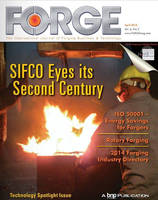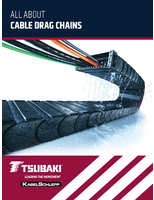Forge - Rotary Forging Celebrates a Century

Carl Lorentzen, MJC Engineering Technology, Inc., Huntington Beach, Calif.
Rotary forging is a cold-forming process invented by Edwin Elmer Slick in 1914. Slick Mills were used to form circular products such as railroad wheels and tire molds. More recently, research to further the process is being conducted at the University of Strathclyde's Advanced Forming Research Centre (AFRC) in Glasgow, Scotland. The AFRC recently commissioned and installed a rotary forging system custom-built by California-based MJC Engineering and Technology Inc.
Rotary forging is a cold-forming process used to forge round shapes. The process deforms a metal blank using a combination of rotation, rolling and axial compression. It is contrasted from a typical forging process (in which material is compressed to shape between two stationary dies) in that a rotary forge system works the billet between two synchronized, non-parallel (skewed) rotary dies. The skewed dies allow for compression in a concentrated area and thus afford a more efficient (smaller forces are needed) method of metal deformation while producing superior mechanical properties.
Nutation
In the 1970s, Dr. Peter Standring at The University of Nottingham in the U.K. developed an advanced rotary forging machine based on the Euler angles of rotation (nutation, precession and spin), which are used today to determine the position of a body in space, such as a satellite.
Nutation is the inclination of the Earth's axis from the vertical (the axis of tilt). Precession is the movement of the Earth's axis as it rotates around the hypothetical vertical axis. Spin is the rotation of the Earth about its own axis. The possible movements of all rotary forging machines are shown in Figure 1 and, when coupled with a simple uniaxial die closure, can be used to cause significant incremental deformation using low forces compared to other techniques of conventional metal forming.
In the early 1980s, a proprietary industrial rotary forging group was formed at The University of Nottingham. Its members included Rolls-Royce Aerospace, GKN, Ford, TI, Eaton, Timken Europe and Rover Cars. In total, the group was comprised of 22 companies from six countries. Having analyzed the process, the university obtained funding to design and build a 50-ton rotary forging machine in which the angle of the axis of a conical die could be continuously tilted during the deformation process. This "Nutation axis" was microprocessor controlled to run in either direction and at any speed within the machine range. The force advantage over conventional forging was found to be in the range 10-100 times, depending on the geometry of the part being formed. The novel kinematic tooling action could be used to form parts in bulk, sheet and tubular materials. It could also consolidate metal powders to extremely high densities impossible to obtain by any conventional technology.
Teamwork
More than two decades later, an aerospace engineer inquired at Nottingham if there was anyone who might be able to help him with a metal-forming problem. As a result, he stumbled across the flickering embers of the former NIROF team. Although working predominantly in the rotary forging area, they naturally developed a significant interest in the whole "family" of Incremental Deformation Processes (IDP), which includes ring rolling, spinning/flow forming, swaging and cross-wedge rolling.
The engineer's interest in IDPs was fired by examples of a large number of parts he was shown, of which all had been "incrementally" formed. These, together with the information on how it might be possible to form net- or near-net-shape components (for which his company paid high prices simply to machine up to 95% of it away as waste), set his mind racing. Knowing the product cost base and also having obtained contacts with people who worked in the highly specialized area of IDP, he commissioned the Nottingham team to carry out rotary forging trials on aerospace materials to see if and how they might be formed incrementally.
The key to this leap forward was the ability to move the axis of nutation during a deformation process between 0 and 45 degrees. Previously, all other machines had been mechanically limited to movement of only a few (typically two) degrees of nutation, and the rest had the nutation axis fixed during the process. The angle of nutation on most machines was less than five degrees from the vertical.
Parts and materials formed on the Nottingham NSRF machine were predominantly netor near-net-shape automotive components of both high and low volume, ferrous and nonferrous. Global manufacturing requirements for smarter, environmentally friendly, energyefficient and flexible output have once again thrust rotary forging into the "serious consideration" category because of what it can offer to obtain high-added-value, low-cost manufacture.
Rotary Forging Gets a Boost in Scotland
In recent times, the U.K. government sought to retrench its manufacturing expertise around things it could do well, like highadded-value (HAV) manufacturing. The establishment of seven specialist centers around the country resulted in one relating to metal-forming based at the University of Strathclyde's Advanced Forming Research Centre (AFRC) in Glasgow, Scotland. Starting with an aerospace agenda, the AFRC began a secondphase expansion in 2011 to double its size and extend its range of activities across other industries (automotive, oil/gas, medical). In line with this, the AFRC also sought to expand its technology portfolio to include special-purpose forging equipment, superplastic forming, flow forming and rotary forging.
History of Rotary Forging
At the turn of the 19th century, it was evident that large-diameter circular products like engine and railcar wheels were difficult to produce in the quantity and to the quality required to support railroad infrastructure. Tackling this problem, Edwin Elmer Slick was awarded the first of a series of U.S. patents in 1907 in which he addressed various design embodiments now known collectively by the term "rotary forging." By 1914, Slick had patented and began building the first of four semi-automatic systems at the Cambria Iron Works in Johnstown, Pa. The Slick Mills, as they were known, hot-formed large circular products from railway wheels to tire molds sleeve wheels to gear blanks until the last one was withdrawn from service by Bethlehem Steel in 1982.
Slick's rotary forging machines could produce one fully formed railway wheel in only 55 seconds. The machines were horizontally mounted like a lathe, and the tailstock was inclined at 10 degrees to the headstock axis, which held the wheel die. The tailstock die was a conical section, and the two dies were made to move toward each other along the workpiece axis while being simultaneously rotated about their own axes.
Slick's success in building his rotary forging machine was that he designed and made what were at the time the world's largest thrust races, which were capable of handling the eccentric loads generated by the process. It was these incrementally applied loads that worked over only a part of the face of a wheel at any time. This meant the instantaneously applied forces produced in the process were only a fraction of the forces required by a conventional forging unit working over the entire cross section.
The process remained unchallenged for producing large circular products such as sheaves, tire molds and gear blanks until the 1970s, when the technology was taken up in Japan and elsewhere as an RD topic at a number of academic institutions. Primary among these was the work done by Dr. Peter Standring at The University of Nottingham in the U.K. He developed a classification system to define all types of rotary forging machines and used it to design and build what was, for many years, the most sophisticated rotary forging machine in the world.
Custom Machinery
MJC Engineering and Technology Inc. of Huntington Beach, Calif., a custom machine-tool builder specializing in metalforming machines, teamed up with the folks at Nottingham to design and build a 200-ton-capacity machine for the AFRC. The company designed a cold-forming rotary forge press that works the material between two synchronized rotary dies that operate at an angle from the parallel. The angle is typically fixed, but it is fully programmable on this custom-designed machine. This configuration allows compression in a concentrated area and provides for more efficient metal deformation, while producing superior mechanical properties in the finished section.
The technology consisted of the top and bottom spindles pivoting from 0-45 degrees, operated by AC vector motors and drives, plus an overall motion control CNC, all supplied by Siemens. The CNC is a Sinumerik 840D, which controls all the axis and spindle motion, hydro and servo positioning valves, plus the synchronization of up to four cylinders for the integrated motion of the rotary dies. In the processing of the workpiece, the control monitors all machine conditions while maintaining the synchronized angles of the twin rotary dies.
In order to avoid the improper deformation of materials during the cold-forming process, programmed motion sequences of the machine must be of high precision. In a manufacturing environment where the high output of parts is critical, this process must remain extremely well-regulated, documented and monitored. The CNC has the capability to upload all data in real time.
During the machine build period, MJC funded work at Nottingham to evaluate the ability of the rotary forging process to form a range of difficult-to-shape "exotic" alloys in the "cold" condition. The results of this work entirely supported the building of the MJC Nutation-Spin rotary forging machine.
In October 2013, the machine successfully completed its onsite trials, and final Glasgow acceptance occurred in January 2014. Although the previously funded MJC work had shown that using limited rotary forging systems could produce surprising deformations of aerospace materials in the cold condition, it was not anticipated how much further such deformations could be taken using the MJC machine. The AFRC's new rotary forging machine is currently processing an assortment of alloys.
Looking Forward
Clearly, these are early days in the reengineering of Slick's pioneering work in rotary forging. As the saying goes, "what goes round comes round." In this case, after exactly 100 years, the global torch of rotary forging machine development has now been picked up by MJC and is back once more where it all began. MJC now has the opportunity to start the next 100-year journey that – given the precision, control systems and improvements in material properties, process simulation and general awareness – ensures huge progress from where we are now.Â




